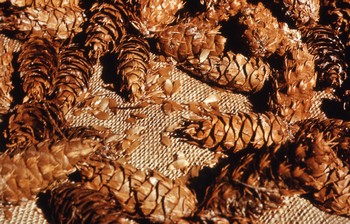PESTS AND DISEASES OF FORESTRY IN NEW ZEALAND
Blast from the past: the parasitoid of the Douglas-fir seed chalcid
Scion is the leading provider of forest-related knowledge in New Zealand
Formerly known as the Forest Research Institute, Scion has been a leader in research relating to forest health for over 50 years. The Rotorua-based Crown Research Institute continues to provide science that will protect all forests from damage caused by insect pests, pathogens and weeds. The information presented below arises from these research activities.
From Forest Health News 306, March 2022
Douglas-fir (Pseudotsuga menziesii) is New Zealand’s second most economically important plantation conifer after radiata pine. In some situations, however, Douglas-fir can spread beyond managed plantations, adding to the wilding conifer challenge.
In the 1920s, a seed predator by the name of the Douglas-fir seed chalcid, Megastigmus spermotrophus, was accidentally introduced to New Zealand, likely within contaminated seed. The Douglas-fir seed chalcid is a seed-feeding wasp from Douglas-fir's native range in North America. The wasp finds an immature Douglas-fir cone in early summer and lays its eggs inside the cone’s undeveloped seeds. When the eggs hatch, the larvae hollow out the seeds from the inside. By the following spring, adult wasps emerge and repeat the cycle.
The presence of the Douglas-fir seed chalcid in New Zealand reduced the ability of local foresters to collect their own viable seed. In response, FRI released the parasitoid wasp, Mesopolobus spermotrophus from Scotland in 1955 to counter the chalcids’ effects on seed production. Mature, unopened Douglas-fir cones were collected in subsequent years and assessed for the parasitoid. These surveys found no evidence of any parasitoid present, so it was concluded that the wasp did not establish1. However, in 2019 researchers from Manaaki Whenua Landcare Research found the parasitoid present when they assessed mature open Douglas-fir cones for seed damage and species presence2. In fact, they found an overall parasitism rate of 48.5% from 13 sites across New Zealand.

How could the parasitoid have remained undetected for so long? The answer lies in the Douglas-fir cones. The historic Douglas-fir surveys collected only closed mature cones and found no parasitoids, whereas the recent collection of open mature cones led to the discovery of the parasitoid's presence. It is now known that Mes. spermotrophus can only parasitize the Douglas-fir seed chalcid when mature cones have opened, as the parasitoid cannot physically access the seeds of closed cones. This simple methodological difference highlights the importance of understanding in detail the ecology of biological control agents that we release.
Overseas, the Douglas-fir seed chalcid can destroy up to 100% of Douglas-fir seeds when conditions are favourable. In New Zealand, seed destruction in the 1940s was up to 20%, but this latest study recorded a maximum of only 0.61% seed destruction, likely influenced by the prevalence of the parasitoid. This incredibly low statistic suggests that the seed chalcid does not reduce seed production of Douglas-fir in New Zealand, and thus may not be a viable option for the management of wilding conifers. Manaaki Whenua Landcare Research have expressed an interest in continuing to look at alternative biocontrol methods to manage wilding conifers.
Mike Davy, Scion
1 Bain, J. (1977). Megastigmus spermotrophus Wachtl (Hymenoptera: Chalcidoidea: Torymidae). New Zealand Forest Service, Forest and Timber Insects in New Zealand No. 14.
2 Lee, S., Fowler, S. V., Lange, C., Smith, L. A., & Evans, A. M. (2021). Unexpected parasitism of Douglas-fir seed chalcid limits biocontrol options for invasive Douglas-fir in New Zealand. New Zealand Plant Protection, 74(1), 70-77.
This information is intended for general interest only. It is not intended to be a substitute for specific specialist advice on any matter and should not be relied on for that purpose. Scion will not be liable for any direct, indirect, incidental, special, consequential or exemplary damages, loss of profits, or any other intangible losses that result from using the information provided on this site.
(Scion is the trading name of the New Zealand Forest Research Institute Limited.)

 Farm Forestry New Zealand
Farm Forestry New Zealand

